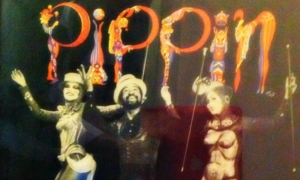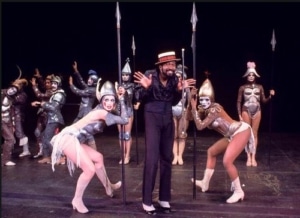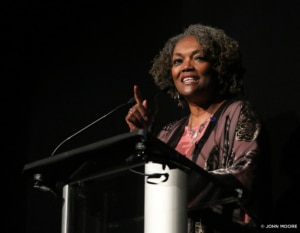DCPA NEWS CENTER
Enjoy the best stories and perspectives from the theatre world today.
Enjoy the best stories and perspectives from the theatre world today.
This article was published on September 16, 2014
Denver actor Candy Brown has five Broadway credits, but her indelible place in theatre lore is linked, alas, to one of the most reviled cult leaders in history.

Candy Brown, left, Ben Vereen and Pamela Sousa made up ‘Pippin’s’ first Manson Trio. Photo courtesy Candy Brown.
Brown was part of the first Manson Trio, a signature Bob Fosse moment in the original Broadway production of Pippin. Brown can be seen in famous photographs stepping alongside Pamela Sousa with top hats and canes wearing white faces and exaggerated smiles just behind their Leading Player, Ben Vereen.
In the show, the young prince Pippin has leapt fully into the world of war. During a clever vaudevillian battle scene intended to expose the charade of war, the Leading Player and his two dancers perform “The Manson Trio” during the song “Glory.” Pippin sours on the whole combat thing and flees to the countryside.
“I always see Candy Brown when I think about the original production,” composer Stephen Schwartz said. “Candy was part of that iconic, weird dance. Hers is one of the faces that people associate with their memory of the original Pippin.”
But people often ask: Why is that “iconic, weird dance” called “The Manson Trio”?

(Front L-R) Kathryn Doby, Ben Vereen & Candy Brown in the Broadway musical “Pippin.”
“It’s because Charles Manson was in the news at that time,” Brown said this week from Denver, where she now works for Denver School of the Arts as a Guest Artist in the theatre department teaching professionalism and body awareness.
“It was very chilling, because here we are doing this ‘vaudeville-style’ dance against limbs being thrown out on stage,” Brown added. “The Vietnam War was still going on, and I believe there was a voiceover during that song where they were reading off the number of people who had died in the war. I don’t even know who first said that term, but it was something like, ‘Oh, that’s creepy. Sort of like Charlie Manson.’ And from then on, it became known as The Manson Trio.
“It was similar to what (Choreographer) Bob Fosse did in Cabaret when he had the young Aryan sing ‘Tomorrow Belongs To Me’ while the war was going on. He liked to juxtapose the entertainment side and the dark side of life at the same time.”
Brown performed in the Pippin company for two years and has remained remarkably close to her family there.

Candy Brown in 2019. Photo by John Moore
“Candy Brown is one of my dearest friends,” said John Rubinstein, who played Pippin in the original Broadway company and is now playing the boy’s father in the revival that launched last week in Denver.
“She came to New York a few weeks ago to see me do a performance of Pippin on Broadway, and she and Ben (Vereen) and I all went out together and reminisced and cried and laughed.
“I so miss her on stage. I watched her do that show for two full years, and she gave 150 percent every single performance. She never, ever gave any less. And given what she had to do in that show — that is saying a lot. She is amazing, and I revere and adore her.”
Since moving to Denver, Brown has performed for the Denver Center for the Performing Arts, most recently in the Colorado New Play Summit staged reading of Zenith. She was part of the Curious Theatre’s company’s world premiere piece on homelessness called The Denver Project. She choreographed Melissa Faith Hart’s world premiere staging of The Scarlet Letter in Parker, and is now directing the ambitious Lyn Ahrens musical Once on This Island (a calypso retelling of The Little Mermaid) through Oct. 5 at the Aurora Fox. Her cast is led by the rising vocalist known as SuCh. Or, as Brown calls her, “The Amazing SuCh.”
“I’ve got the best voices in town,” Brown said. “These are some singing mama-jamas.”
John Moore: Can you take us back to a time when a young Candy Brown stepped into the Pippin auditions in 1972?
Candy Brown: It’s funny. I had just worked with Bob Fosse on a TV concert film called Liza with a Z. I was on the road with Applause when I got the call from his assistant saying that Bob would like to have me audition for this new show he was going to do called Pippin. I had never done a show from the ground up. I had always been a replacement. And so I just thought, ‘Oh, so that’s how it works. The choreographer calls you up and tells you what you are doing next.’ I didn’t know for three months after Pippin was open that I was the only one from the TV special that he had called.
John Moore: I have enjoyed talking to people who were there in 1972 about ‘the real Bob Fosse.’ So … who was ‘the real Bob Fosse’?
Candy Brown: Wow. Now that’s a two-day conversation. Bob was very quiet-spoken. He loved his profession. What a lot of people didn’t know is that he loved actors. Jill Clayburgh (the original Catherine in Pippin) was not a singer/dancer. John Rubinstein (the original Pippin) was not known as a singer/dancer. Even Irene Ryan (Berthe) was not known as a singer/dancer. She had done some vaudeville in her youth, but she was an actor. Bob even studied Sandy Meisner’s acting technique so he could better communicate with actors. He always knew that he wanted to direct, and from some of the films he did, you can see how passionate he was about working with actors. He was the first choreographer I ever worked with who didn’t just say, “… a 5-6-7-8.” He told you where you were, and why you were doing what you were doing. I remember distinctively that opening number. We came through the curtain to sing Magic to Do, and then we started talking to the audience. He wanted us very specifically to do that sideways walking. He wanted us to talk to them; ask them questions — but always act like you have a secret. I remember I was very uncomfortable in those very skimpy costumes, and I was scared to have my dad come see the show.
John Moore: People talk about his legendary temper, but you strike me as the kind of woman who would not have stuck around and taken it.
Candy Brown: Everybody had a different relationship with him. I did see him be very cruel to some people. He always seemed to have one whipping boy in the cast. He did come on to a lot of women. When he first started coming on to me, I was so naive, I didn’t even know that’s what was happening. I thought he was just being very nice to me. He asked me if I lived alone. And then another time, we were at a party and he asked me to stay. And I was like, ‘No, I’ve got to go home and feed my dogs.’ It took me a minute to realize that was a come-on. But c’mon: I’m 19 years old and had just come from Minnesota. He’s a 45-year-old balding white guy. It never occurred to me that there would be anything between us. I was young and I didn’t expect it, so I just didn’t see it coming.
John Moore: What does it mean to you to be a part of that whole Pippin/Manson Trio history?
Candy Brown: How lucky can one person be? Seriously. I had a lot of friends who did flop after flop after flop. They did 10 times as many Broadway shows as me, but none that had the success of just the few that I did. I was in the right place at the right time. I had nothing to do with it.
John Moore: I think you had a little bit to do with it.
Candy Brown: I will say I came in with the right attitude. I had a strong work ethic, and I had versatility. Bob loved people who had ballet training. But he also had a specific style. He gave you a lot of opportunity to see if you could come up with the exact style that he wanted done. That’s where a lot of people just couldn’t quite do it. Everybody thinks it’s where you put your hands, and where you put your knees, and where you put your toes. That has a lot to do with it, but it’s more where it’s coming from on the inside.
John Moore: Whenever I talk to you about Pippin, you’re always saying how you just had lunch with John Rubinstein, or just saw Stephen Schwartz or Ben Vereen in New York. I think Pippin must have been like a high-school theatre experience for you, because 40 years later, no one stays in touch like you all do.
Candy Brown: But that’s because most of us did that show for two years. So we became a family. For example, when we did Chicago, even though I am still close to a few of those actors, that was a tougher time for all of us, because Bob was coming out of his heart attack, and he wasn’t the same person he had been before. I didn’t really how many medications he was still on. So we all kind of banded together — but that was a different kind of holding on to each other. Now, Pippin? We all just had such a great time. We were all so young, and we meant a lot to each other. We supported each other. We took care of each other. I am grateful that I am still in touch with these people. I also still talk to Roger O. Hirson, the writer of the book. He is in his mid-80s now. I adore him and also speak with him often.
John Moore: Now tell me about how you know Lucie Arnaz. Because that can’t have anything to do with Pippin.
Candy Brown: Lucie was best friends with my New York roommate. They had done Sea Saw together and a couple of other shows. So I became a friend by association.
John Moore: So what did you think when you heard that the new Pippin revival was going to launch its tour in Denver?
Candy Brown: Oh my God, I couldn’t be more excited. I said, ‘No wonder I moved here.’
John Moore: It does start to sound like this is all happening to some sort of preordained plan.
Candy Brown: Yeah, isn’t that crazy? But my life has always been like that. I got a fortune cookie a few months back and it said, ‘You have spirit guides.’ And you know what? I always have.
John Moore: I am a former high-school theatre teacher myself, so this is a big, open-ended question, but: At this point in your life, why is teaching at Denver School of the Arts what you want to be doing?
Candy Brown: Because since I was 5 years old, I wanted to be an elementary school teacher. That’s what I went to college for originally. But life just took a different turn. And now, here I am, with the opportunity to teach. When my sister started kindergarten, she was already reading at a third-grade level, and that’s because I was in the third grade. I would come home and teach her. That’s why she got to skip a grade. That’s why she got a scholarship to Harvard. I would tell her, ‘I made you!’
John Moore: So what happened?
Candy Brown: Well, I started dancing when I was 2. But I had to stop when I was about 11. My father was in the Air Force, and we moved around. We got to Okinawa Island when I was in the sixth grade, and there wasn’t anybody there who was dancing at the level I was. I had had a magnificent dance teacher in Queens. I would say there wasn’t a Broadway show from 1950 to 1980 that she didn’t have a student in.
John Moore: What was her name?
Candy Brown: Bernice Johnson. She had been a Cotton Club girl. She taught us everything. We had tap, ballet, acrobatics, African, interpretive — you name it. That’s where I learned professionalism. Most of the kids from there went to performing-arts high school, but I had to leave the country. That was always a big heartbreak of mine. But it turned out OK.
John Moore: How did you get back into it?
Candy Brown: When I was in high school (in Minnesota), I took a dance class as a P.E. requirement and went, ‘Wow. I forgot how much I love this.’ And that was it.
John Moore: How did you originally come to Colorado?
Candy Brown: The first time I came was with the touring company of Applause. That was right before I started Pippin in 1972. I came back in the ’80s for South Pacific and House of Flowers, and I just always liked it here. It’s always had a nice vibe. I never really stayed more than a few weeks at a time, though, and I knew I couldn’t make a living here as an actor, so I never thought about moving here. And then L.A. got to be just too much for me. It got too old and too tired. I wanted to have an easier life and live at a slower pace. My son was just starting at UCLA, and I thought, ‘Denver is still close enough that I can get back.’ I couldn’t afford to go back east, and I can’t do all that rain in the Pacific northwest. So I thought, ‘Well, let me try Denver. It doesn’t mean I am going to stay here for the rest of my life, but let’s see what happens.’ So I just showed up. And I had no plan. I didn’t know what I was going to do. I figured if push came to shove, I could work at King Soopers or Frontier Airlines or whatever. That was in January of 2008.
John Moore: What was it like for you to see this new incarnation of Pippin in Denver?
Candy Brown: I liked it in Denver much better than when I saw it in New York, frankly. But I think that was purely because of the shock factor. When I saw it in New York, it was too much to absorb for someone who was there originally. You know, it’s hard to divorce yourself from something you were so close to. But when you can finally put that distance between you and it, then it’s all good. And now that I have seen it again, I can go, ‘Oh, OK. I get it. Yeah, that’s great.’ The thing is: This is a different century. What excesses we had in the ’70s look so small compared to the excesses we have available to us now. So I love the whole circus aspect, and that everything is done to excess. The storyline is still very clear. This is an everyman’s journey; the story of a boy who is trying to make a mark in this society. That’s Pippin.
John Moore: What was it like when you talked to Ben Vereen about the new show?
Candy Brown: He just said, ‘This is a show for the 21st century.’
Born in Northern California to an Air Force father
Attended Kindergarten through Grade 5 at P.S. 123 in Queens
Attended grades 6-7-8 on Okinawa Island (Japan)
Attended grades 9-12 in Duluth, Minn.
One year of college in St. Paul before moving to New York City
Broadway credits:
Hello Dolly (she played a replacement Horse!); Pippin (Player); Chicago (June); Grind (Kitty); Two Shirley MacLaine special engagements (Dancer)
Film highlights:
Ali (Mrs. Clay); Zebrahead (Marlene); Lost in America (Co-Star)
TV highlights:
E.R.; Six Feet Under; Ellen; Chicago Hope; Nash Bridges; NYPD Blue
